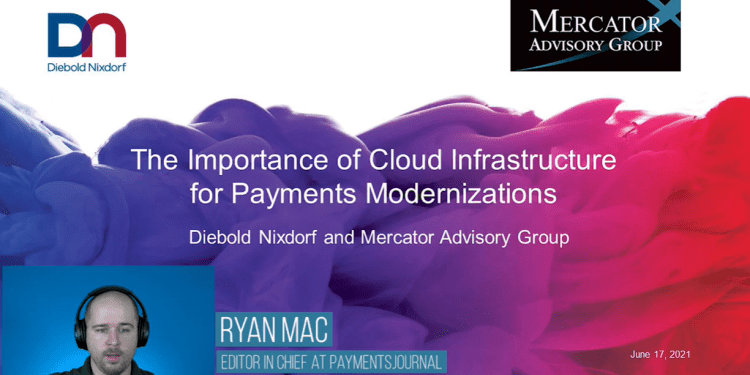In the modern world, a breadth of alternative payment options and instruments are entering the market at an accelerated pace. These options put consumers in the driver’s seat when it comes to making payments, continuously raising the expectations they have of financial institutions and issuers.
For banks and issuers still relying on legacy technology and siloed systems, rising consumer expectations are a challenge. That said, failing to meet them is not an option. To stay relevant and competitive, financial institutions need to embrace ongoing change and seek out modern approaches. One way to modernize is by incorporating API driven cloud-native infrastructure into their offerings.
In a recent PaymentsJournal webinar titled “The Importance of Cloud Infrastructure for Payments Modernization,” guest speakers Markus Doeinghaus, Global Engagement Manager, Payment Solutions and Innovation at Diebold Nixdorf, and Tim Sloane, VP of Payments Innovation at Mercator Advisory Group, explored why embracing cloud solutions is a must moving forward.
Legacy systems don’t meet modern expectations, but cloud infrastructure does
Today, many financial service providers are facing complications and high costs due to payment complexity. This is particularly true for banks still relying on legacy technology stacks that cannot cater to the complex technology and regulatory requirements of the modern world.
Banks recognize these challenges. A 2021 Finastra survey of 150 financial institutions found that only 14% of financial institutions currently have any cloud deployed. One in three (33%) indicated that multiple payment solutions are too complex and expensive. Even more respondents (35%) indicated that access to real-time or intraday information is the top issue they’re facing, and 11% indicated cross-border payments are inefficient. The takeaway? Payments complexity complicates everything and increases costs.
“We believe there is a case for change. We believe that banks need to think about how to keep up, especially with the innovation that is needed in order to provide consumers [with] new ways of interacting with banks and new ways of [making] payments,” said Doeinghaus.
While this is difficult to accomplish with existing systems, modern technology provided in a cloud-native API-driven ecosystem enables banks to deliver a future platform that meets their customers’ needs. By doing so, multiple aspects of the payments process can be improved, from cost, time-to-market, security, consolidation, regulations, authentication, and so on.
Cloud solutions put customers back in the driver’s seat
Moving forward, consumers will expect more control over the payments experience from start to finish. “Consumers will expect that eventually [they] can combine multiple accounts from multiple banks and have one view of [their] aggregated financial situation. That is a big, big play,” said Doeinghaus.
This control goes beyond aggregating financial information. “It’s really putting the consumer back into the driver’s seat, not only by allowing him to choose different methods [and] choose the channel of choice for a specific payment, but also how to manage their payments,” he added.
While it’s easy to say that migrating to cloud-native platforms can enable banks to better serve customers, they might not know where to start. Fortunately, there are plenty of options for banks looking to modernize.
“There’s no shortage of third parties that have services that financial institutions should be looking at. The challenge they have are their siloes and their inability to integrate; this will fix it,” explained Sloane. This includes platforms that can integrate with existing technology and enable software development without a heavy lift.
Ultimately, these services will require a structure that enables software development, open APIs, and third-party applications and operating on the cloud is an approach that will bring with it safe deployment, reliability, and scalability.
“The Holy Grail of getting access to people and services”
According to Doeinghaus, a cloud-native platform can be viewed as the Holy Grail of accessing people and services. This is because these platforms enable banks to test and launch new elements, services, and consumer features without the heavy lift or high cost.
Cloud-native technology makes increased transparency possible and grants access to services and talent around the world that were not accessible via legacy technology. Even more importantly, it puts the consumer at the center of the payments process. End-in-mind, a consumer-centric approach will be crucial for the future of payments.
Learn more about how cloud infrastructure can fuel payments modernization
In the webinar, Doeinghaus and Sloane dig deeper into how banks and issuers can take advantage of the opportunities that come with a cloud-native approach. They also discuss other approaches, including microservices architecture, low-code environment, continuous integration/continuous delivery (CI/CD), and API and third party integration.
Fill out the form below to access the complimentary PaymentsJournal webinar, “The Importance of Cloud Infrastructure for Payments Modernization.”











